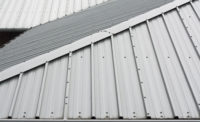Roofing Assemblies
Section 1503.3 Coping. Parapet walls shall be properly coped with noncombustible, weatherproof materials of a width no less than the thickness of the parapet wall.Code Interpretation
This code implies that a separate waterproofing material is to be applied over the top of a parapet wall. The designer cannot leave the masonry, concrete or wood substrate exposed to the elements. This is a critical design and code element that is often overlooked. The top of the parapet wall is highly vulnerable to moisture infiltration.Waterproofing can consist of any approved waterproofing material that is suitable to the existing substrate. Applications of sealants, flashings, masonry coverings or termination metals are acceptable. The most common type of parapet coping is a metal coping that is fabricated out of galvanized metal. Metal copings applied at the perimeter of the structure must be in compliance with ANSI/SPRI ES-1, which requires the use of tested and certified materials and states securement requirements based on the wind zone region of the structure.
Waterproofing Code: Section 1807
Dampproofing and Waterproofing
1807.4.1 Floor base course. Floors of basements, except as provided for in Section 1807.1.1, shall be placed over a floor base course not less than 4 inches (102 mm) in thickness that consists of gravel or crushed stone containing not more than 10 percent of material that passes through a No. 4 (4.75 mm) sieve.Exception: Where a site is located in well-drained gravel or sand/gravel mixture soils, a floor base course is not required.
Code Interpretation
This section implies that a base course a minimum of four (4) inches (102 mm) thick is required under all basement floors. The base course shall consist of gravel or crushed stone that does not allow more than 10 percent passage through a No. 4 sieve, which is 4.75 mm.The only exception to this is if the basement floor is located in an area that is well drained through gravel or a sand and gravel mixture.
Section 1807.1.1 defines a basement this way: “a basement is considered a story above grade plane if any portion of the basement wall is located above the ground level.”

